Company of Heroes 3 multiplayer is a chaotic, stressful meat grinder—and loads of fun
Hands-on with the latest pre-alpha demo.
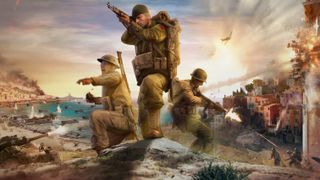
Heading into Company of Heroes 3's multiplayer pre-alpha, I've got a plan. "I'll start with a comp stomp," I tell Relic, hoping to nab myself an easy victory in an AI skirmish. With several developers watching over Discord, I'm feeling the pressure, and I want to put on a good show. The show I actually put on, unfortunately, is a tragedy.
I spend most of this first match fighting with the AI over a single capture point in a village square that rapidly becomes unrecognisable as the ground is turned into craters. The first couple of confrontations go well as I outmanoeuvre my computer opponent and squash a few of their squads, but Company of Heroes 3 is a game where a few explosions can change everything.
Killzone
Within the space of 30 seconds, I go from feeling like I'm doing quite well, to impotently shouting at my little recon jeep, telling it to flee as the Germans turn it into a smouldering wreck. Recon vehicles aren't a great help in a fight, but their ability to identify units normally hidden by the fog of war makes them instrumental. I probably should not have driven it into a cramped area where it could easily be surrounded. RIP, little buddy.
There's no time to grieve my jalopy before the wall I ordered some infantry squads to hide behind is suddenly replaced by smoke and rubble. My squads are no more. If even one little bloke had made it out of that mess, I would have been able to command him to retreat back to HQ quickly, and thanks to the automatic reinforcement system he would have eventually been joined by new squadmates. But since nobody survived, I've got to call in some assistance from the skies.
I'm playing as the USF Airborne battlegroup, one of two currently available for the US faction, and one of four in this multiplayer preview. While the singleplayer campaign lets you build your forces out of whatever companies and detachments you want, even creating hybrids with US, UK and Commonwealth units, the multiplayer battlegroups are preset fighting forces with broad roles that favour different playstyles.
Company of Heroes 3 is a game where a few explosions can change everything.
The USF Airborne battlegroup, naturally, gets a lot of assistance from above, whether that's paratroopers, bombing runs or recon. On the German side, there's the Luftwaffe, which is comparable but with some unique tricks that make it very hard to move once their battlegroup entrenched. Then there's the USF Armored battlegroup, which gives you lots of mechanised options and is deft at playing a support role. One of its most helpful units is a recovery vehicle that's able to grab wrecked vehicles from any faction, fixing them up and letting you commandeer them. Its counterpart is the German Breakthrough battlegroup, which is all about heavy armour and artillery support—perfect for a bit of shock and awe.
My unlockable abilities are split into two trees, one focused on planes, and one focused on dropping shit out of planes. They aren't mutually exclusive, however, so I can enjoy the benefits of both. I've already unlocked the paratrooper ability, and this helps me to speed up reinforcements after the earlier devastation by just chucking some new lads out of a plane. The plane itself gets blown to smithereens, the wreckage falling right next to my base, but all the troops make it out in time.
The biggest gaming news, reviews and hardware deals
Keep up to date with the most important stories and the best deals, as picked by the PC Gamer team.
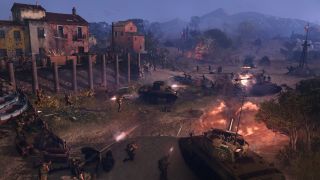
The paratroopers make a valiant attempt to avenge my recon jeep and the poor lads who were hiding behind that former wall, but sadly they don't survive for much longer. And as I focus on funnelling more troops into what is quickly becoming a graveyard built just for my men, the AI is getting beefier and beefier, plonking down new buildings and bringing its more powerful units into the fray. I wish I could do the same, but my economy is in shambles. My enemy takes pity and puts me out of my misery.
Do-over
With one loss under my belt, I mix things up a bit for Battle #2, picking the German Breakthrough battlegroup. I'm backed up by a developer, but also facing another developer and their AI ally. I wouldn't say I'm confident, but this tank and artillery-loving battlegroup feels made for me. Tough armoured vehicles and lots of explosions—what more do I need?
Tough armoured vehicles and lots of explosions—what more do I need?
As much as I'm keen to cause some damage with my tanks, it's my speedy recon bike that becomes my first MVP candidate. It's a lot more nimble than the American jeep, and unlike most vehicles it can capture territory. So not only does it give me a bead on where my opponents are mustering, it also lays the groundwork for a strong early economy. I quickly fill my pockets with enough resources to build a sizable force, which really gets into it in the centre of the map.
This is the location of one of the victory points, and it's the one we decide to go for first. Coming from the west, my ally and I have a height advantage, making it easier to hold off the Americans trying to cross the bridge to our east. It's still a brutal fight, mind, leaving behind plenty of bodies and burning wrecks on both sides. We manage to take the point, after which I secure the location by occupying a tall building and turning it into a forward base capable of churning out new infantry squads. My dev pal has also brought in a medical truck, which passively heals any troops in its radius. We dig in.
Since the centre of the map is under our control, I send some squads out hunting. That's when things start to turn. Expecting the Americans to try and capture some nearby territory, I hide my lads behind some hedges and wait. A few seconds later and they are all dead. So many brave soldiers, their lives snuffed out in an instant by carpet bombing. As I try to recover, the Americans manage to get behind us in the north, and start pushing in the south. They're starting to surround us.
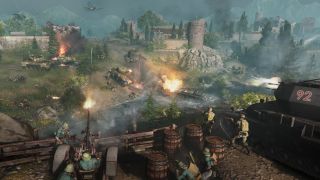
The chaos of multiplayer, especially when it's more than 1v1, is a sight to behold. There's stuff happening all over the map, but even right in front of you there's often so much going on that, initially, it can be hard to wrap your head around. Duelling tanks, infantry getting mown down by strafing runs, artillery pounding the area until it's been terraformed, paratroopers dropping down from the sky, buildings collapsing—there are moments where I forget all about what I'm meant to be doing and just stare, impressed and intimidated. Maybe a bit confused.
In singleplayer skirmishes and campaign battles you can give yourself some breathing room with the tactical pause. Compared to the system in Relic's previous games, like Homeworld and Company of Heroes 2, it's been pushed more to the forefront and fleshed out, and it's saved my bacon many times already. It lets you freeze the action and queue up commands, letting you pull off more elaborate manoeuvres at your own pace, which is wonderful if, like me, you are old and slow.
Unsurprisingly, that's not possible in multiplayer. While Relic emphasises that Company of Heroes is not an APM RTS and you don't need to have the superhuman dexterity of a 20-year-old StarCraft player, there are still a lot of plates to spin. There's also a palpable friction between the micro and macro that forces you to prioritise, smashing a few of them to save the rest.
Fighting on a constantly shifting battlefield with vanishing cover means that, unsurprisingly, Company of Heroes 3 can get pretty micromanagement intensive. On the bigger maps, you're not going to be present for every battle, so you've got to prioritise, but that doesn't mean your troops can't be effective without constant babysitting. The addition of side armour means your tanks are no longer as vulnerable to high-damage rear shots, and you can order your troops to quickly scarper to safety just by hitting the retreat button.
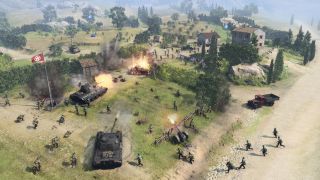
It can be easy to forget when you're losing troops as quickly as I do, but there's a veterancy system that rewards you for keeping your troops alive and killing. Veternacy has always been a core feature of Company of Heroes, serving as both battle mechanic and narrative device. It gives more weight to the losses and victories, more risk, more rewards, while, simultaneously evoking the series' cinematic inspirations, Band of Brothers in particular, by turning it all into a wartime drama. When I see my little flamethrower-wielding engineers getting into trouble, I do everything I can to save them, primarily because damn those flamethrowers are handy when you need to empty a building, but also because I know these little guys now—I've watched them develop and gotten used to their barks.
Rank up
The philosophy behind veterancy remains the same in Company of Heroes 3, but the system itself has been fattened up considerably, and now works differently depending on the faction you pick. For the US forces, you get two veterancy specialisation options per unit, but with the Wehrmacht it depends on what Field Marshal you select. The German faction gets three of them, each conferring unique upgrades, abilities and veterancy bonuses. Pick the Special Operations Field Marshal, for instance, your basic infantry get incendiary grenades, tanks get camouflage netting, and bunkers can be upgraded to observation bunkers. And when your infantry hits the first veterancy rank, they'll be able to capture territory faster.
There are moments where I forget all about what I'm meant to be doing and just stare, impressed and intimidated.
My German Breakthrough battlegroup really starts to shine in the midgame, once I've unlocked my bag of armoured tricks, but even then disaster is nipping at my heels, like when my 'menagerie of metal'—a big group of armoured vehicles supported by some fresh infantry—gets caught in a pincer manoeuvre. In almost no time at all they go from a terrifying force to not existing at all. This is becoming a habit. But I still have all the victory points under my control, and with my enemies running out of reinforcements, they decide to make a push for one of them. It's devastating. I only have a few squads of infantry left in the area, and they aren't a match for the wall of American armour slowly rolling into my territory. It should have been my wall of armour intimidating the Americans!
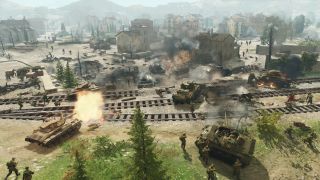
Things turn yet again. A combination of infantry sacrifices and incendiary strikes chips away at the oncoming metal monsters and the troops rushing in behind them, slowing them down for long enough so that I can move some newly recruited vehicles into position. They aren't quite enough to destroy the enemy force, but they do enough damage that the Americans are forced to retreat, presumably for repairs, right after they take the point. Also, I have a Tiger heavy tank now! This burly boy is a god of war, and with a small escort is able to reclaim all my territory and then start hunting enemy tanks. When they see it rolling in, they flee. That's it for the Americans. With no victory points and a Tiger chasing them, they are done for. The victory screen appears. I'm surprised, but extremely happy.
Even right there at the end, with the Americans bleeding reinforcements, it still felt like anything could happen—my victory wasn't assured. A perfectly-timed bombing run or sneakily-placed anti-tank weapon can completely ruin someone's dastardly plans, and a single powerful unit, like my beloved Tiger, can cause everyone to scatter. Few plans can really survive a confrontation with the enemy, so you're always being forced to adapt, constantly on the edge of your seat. It's a stressful, sweaty delight.
You can jump into some multiplayer matches and skirmishes yourself tomorrow, on November 30, when the multiplayer pre-alpha launches on Steam. Just visit the official site and sign up for the 'CoH-development' programme and you'll get access to all the preview slices when they launch.

Fraser is the UK online editor and has actually met The Internet in person. With over a decade of experience, he's been around the block a few times, serving as a freelancer, news editor and prolific reviewer. Strategy games have been a 30-year-long obsession, from tiny RTSs to sprawling political sims, and he never turns down the chance to rave about Total War or Crusader Kings. He's also been known to set up shop in the latest MMO and likes to wind down with an endlessly deep, systemic RPG. These days, when he's not editing, he can usually be found writing features that are 1,000 words too long or talking about his dog.
Most Popular

